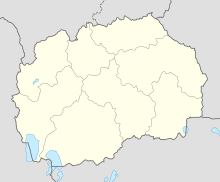
Back فتح سفيتغراد Arabic Обсада на Свети град Bulgarian Опсада на Светиград (1449) Macedonian Beleiringen av Svetigrad (1448) NB Осада Светиграда (1448) Russian Beteja e Sfetigradit (1448) Albanian Kocacık Kuşatması Turkish
| First siege of Svetigrad | |||||||
|---|---|---|---|---|---|---|---|
| Part of Albanian–Ottoman Wars (1432–1479) | |||||||
 Engraving of an engagement during the siege of Svetigrad. | |||||||
| |||||||
| Belligerents | |||||||
| League of Lezhë | Ottoman Empire | ||||||
| Commanders and leaders | |||||||
|
Skanderbeg Pjetër Perlati |
Murad II Prince Mehmed[2] | ||||||
| Strength | |||||||
| 2,000 men garrisoned;[3] 8,000 men stationed in the surrounding countryside[3] | 80,000-120,000[3] | ||||||
| Casualties and losses | |||||||
| Fortress surrendered but the garrison was spared.[4] | 20,000 casualties[5][7] | ||||||
Location within North Macedonia | |||||||
The siege of Svetigrad or Sfetigrad began on 14 May 1448 when an Ottoman army, led by Sultan Murad II, besieged the fortress of Svetigrad (now Kodžadžik, North Macedonia).[8] After the many failed Ottoman expeditions into Albania against the League of Lezhë, a confederation of Albanian Principalities created in 1444 and headed by Skanderbeg, Murad II decided to march an army into Skanderbeg's dominions in order to capture the key Albanian fortress of Svetigrad. The fortress lay on an important route between present-day North Macedonia and Albania, and thus its occupation would give the Ottomans easy access into Albania.
At the same time, Skanderbeg had been at war with Venice. Realizing the magnitude of his challenge, Skanderbeg attempted to relieve the garrison by engaging in skirmishes with the Ottoman army. His forces succeeded in inflicting heavy casualties on the Turkish forces through guerrilla-style attacks. Efforts were made by Skanderbeg to use intelligence forces, operating as far as Constantinople, to gather information on Murad's plans of action. Meanwhile, near Scutari, he had been able to defeat a Venetian force and managed to considerably weaken the Venetian presence in Albania. Despite these efforts, on 31 July the garrison of Svetigrad surrendered due to a disruption in the water supply. The garrison was spared and a force of Ottoman Janissaries was stationed inside the fortress instead. Two years later, Murad would march against Krujë, only to suffer a heavy defeat.
- ^ Some sources refer to the siege occurring in 1449. Most original documents, however, only refer to it happening in 1448. See: Schmitt p. 93.
- ^ Fatih devri üzerinde tetkikler ve vesikalar Halil İnalcık
- ^ a b c Francione p. 77.
- ^ Hodgkinson p. 102.
- ^ Francione p. 79.
- ^ Rrezja, Agon. Zbulohen varret e betejës së Sfetigradit!. Weblog entry. Humanisticus. August 2, 2007. July 8, 2009 [1].
- ^ The graves for the soldiers who died during the siege of Sfetigrad have been found in the village of Kodžadžik near Debar. They contain approximately 300 Christian corpses and approximately 900 Muslim corpses; the graves were separated to correspond to the religious affiliations of the fallen.[6]
- ^ Aleksandar Stojanovski (1989). Makedonija vo turskoto srednovekovie: (od krajot na XIV-početokot na XVIII v.). Kultura. p. 412. Retrieved 6 April 2013.
© MMXXIII Rich X Search. We shall prevail. All rights reserved. Rich X Search
